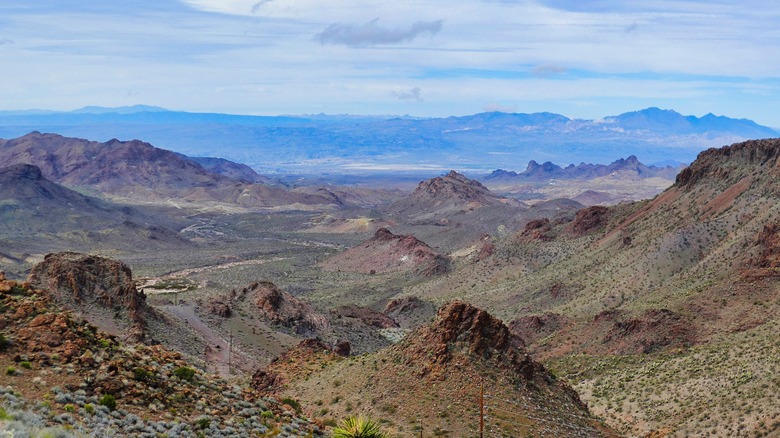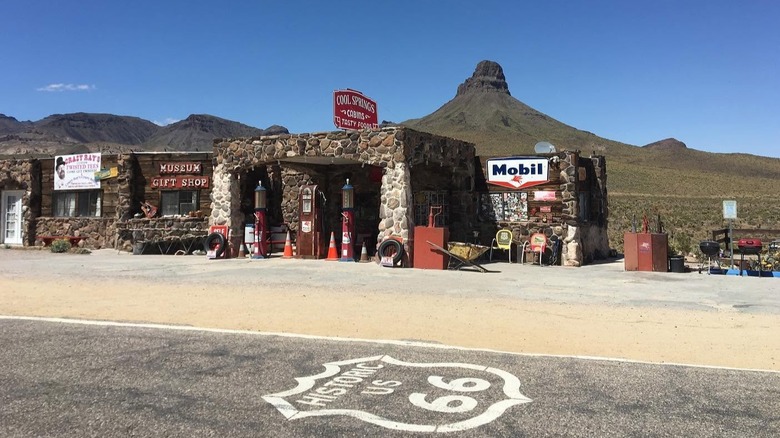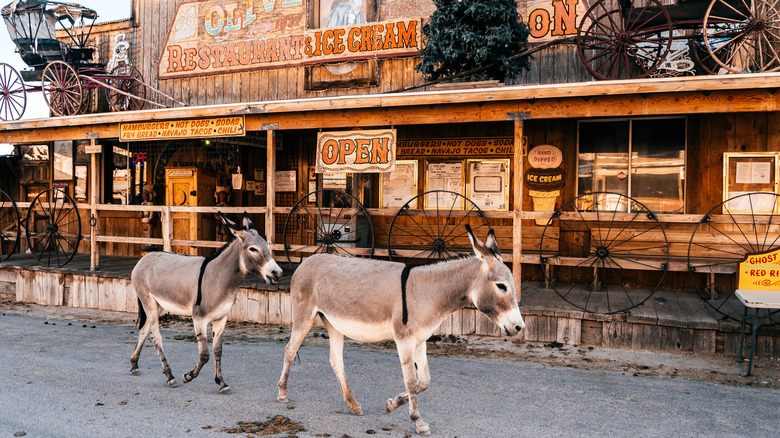Daredevils Love Driving Arizona's Historic Highway That's As Scenic As It Is Dangerous
Arizona's Oatman Highway is perhaps the most legendary — and most dangerous — section of historic Route 66, America's most famous road trip, stretching from St. Louis to California. The narrow, 48-mile Oatman Highway follows switchback after switchback as it winds its way through the Black Mountains, from just outside of Kingman, Arizona, west to the Colorado River and the California Border. You'll quickly appreciate the wisdom of adhering to the 15 mph speed limit when you glimpse the rusting hulks of cars resting at the bottom of the sheer drop-offs. Legend has it that travelers of the era would sometimes hire a local to drive their car up the treacherous Sitgreaves Pass (pictured), or even have it towed up and down to avoid the dangerous roadway. But unless you're driving a Model T, your modern automobile should make it just fine.
This is the route the Joad family took to get from Oklahoma to California in John Steinbeck's "The Grapes of Wrath." The novel dubbed Route 66 the "Mother Road," as it carried refugees from the Dust Bowl as they fled west. In the 1950s, a saner, flatter roadway at a lower elevation replaced this segment, leaving the Oatman Highway as a thrilling scenic route to be taken slowly and savored — perhaps with a dose of Dramamine.
But it's worth it for the sweeping views of the Mohave Desert, and the glimpses into history along the way. "My husband and I drove Route 66 from St. Louis to California and this was our favorite stretch of the mother road! The turns feel just like radiator springs at Disneyland," one Tripadvisor traveler writes.
Driving Oatman Highway
Twenty miles outside of Kingman you'll see an old stone gas station at Cool Springs, now a roadside museum and gift shop that's worth a stop for cold Coke in a vintage-style glass bottle. You might see a classic car or two out for a Sunday spin, posing by the non-operational vintage gas pumps. If you have a CD player in your car you can pick up a copy of an audio tour to accompany your journey. Before you leave, follow Rick Steves' best road trip advice and take a quick 0.8-mile walk up the Mesa Trail to a pretty viewpoint.
Your next stop is at a secret spring, Shaffer Fish Bowl, a few hairpin turns up the road. This is a tiny oasis, with a rock-walled pool built in the 1930s, where monkey paw orchids bloom. Locals have a quaint tradition of keeping it stocked with goldfish. Then enjoy the ever-increasing views as you wind your way up to Sitgreaves Pass. Take advantage of the many turn-outs so that the driver can take in the views — their eyeballs will need to be glued to the road while driving. Keep an eye out and you might just see a roadrunner. You'll recognize the bird from its crazy gait, legs windmilling in a blur — it looks exactly like the Looney Tunes cartoon character it inspired.
When you reach Sitgreaves Pass, you'll get your first glimpse down into the Colorado River Valley and the Mojave Desert. You're looking at California, Nevada, and Arizona all at once. Pictures scarcely do justice to this view, as it's all about volume and space. Next stop: the town of Oatman.
Exploring historic Oatman
The Gold Rush brought 10,000 miners to the region at the turn of the 20th century, when Oatman became a boomtown. Today the town looks like something out of a vintage western, and the 1961 John Ford classic "How The West Was Won" starring John Wayne and Jimmy Stewart was filmed here. The wooden sidewalks and rustic storefronts now house gift shops where you can buy souvenirs and local handicrafts.
Oatman is sometimes called a "living ghost town," with a population of 94, but people come to Oatman to visit its four-legged residents, the herds of burros descended from the gold miners' working stock. These colorful characters are as friendly as puppy dogs, cozying up to tourists for selfies in exchange for hay cubes purchased from local vendors. (There used to be apples and carrots on the menu, until the burros came down with diabetes.)
The heart of Oatman is the historic Oatman Hotel. Hollywood "it" couple Clark Gable and Carole Lombard spent their wedding night upstairs after a quickie elopement in Kingman. Gable was in the middle of filming "Gone With the Wind" at the time, and he was known to frequent the hotel, where he gambled with the local miners. The hotel no longer rents rooms, but you grab a stool at the Dollar Bill Bar, where the walls and ceiling are papered in dollars signed by generations of patrons — a quaint western practice started by those gold miners and continued today by tourists — just ask the bartender for a pen and add yours before rolling on down to the end of the road at the Colorado River. Take a right and you'll find yourself in the gambling town of Laughlin, Nevada, and back in the 21st century.


